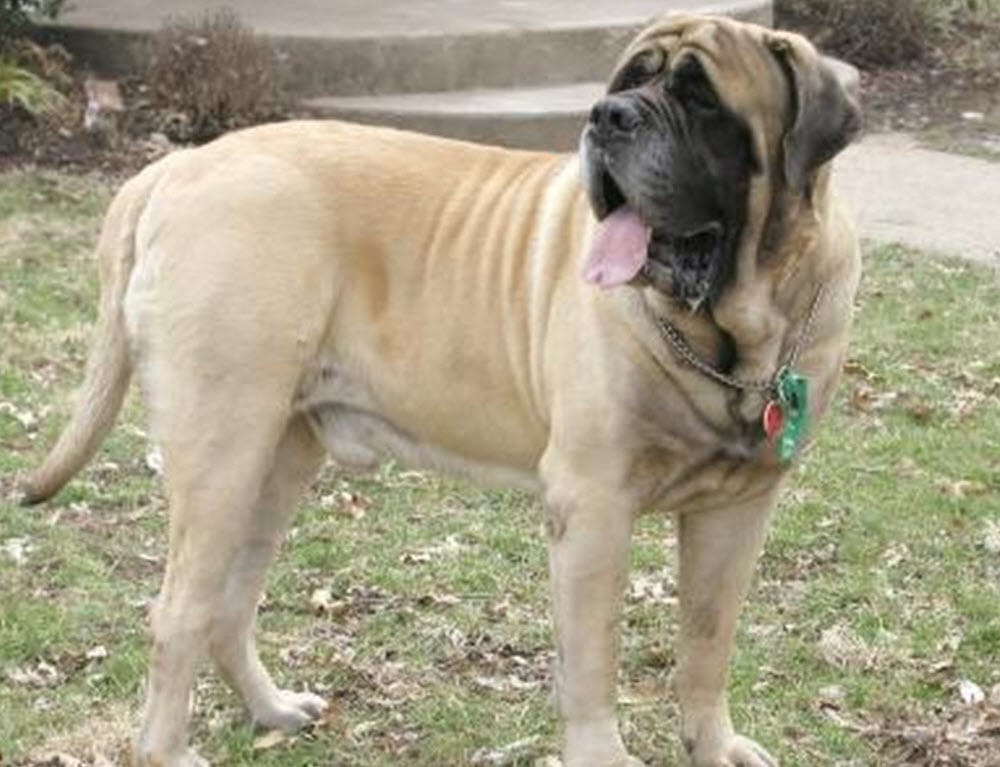Imagine a gentle giant lounging in your living room, its massive head resting peacefully on its paws. That’s the English Mastiff, embodying both grandeur and gentleness. This post peels back the layers of what it takes to keep such a magnificent dog breed thriving. You’ll learn how to tailor their environment for comfort, from space needs to bedding choices.
We dive into crafting the perfect diet plan that keeps them healthy and happy because getting nutrition right is crucial for these giants. Additionally, we directly confront prevalent health concerns, offering guidance on recognizing them early and taking steps to prevent them.
Owning an English Mastiff comes with its highs and lows; we lay it all out so you know exactly what joys and challenges lie ahead. As they age gracefully by your side, understanding how to adjust care is key—this post covers lifespan insights and dietary and exercise tweaks for older dogs.
Table Of Contents:
- AI illustration of an English Mastiff
- Common Health Issues in English Mastiffs
- Understanding the English Mastiff’s Habitat Needs
- The English Mastiff Diet Plan
- Pros and Cons of Owning an English Mastiff
- Lifespan and Aging Care for English Mastiffs
- English Mastiff Needs It’s Space
 AI illustration of an English Mastiff
AI illustration of an English Mastiff
Common Health Issues in English Mastiffs
But, just like any giant, they come with their own set of health concerns that you need to be aware of.
Hip Dysplasia
This condition is akin to a mismatched puzzle piece where the hip joint doesn’t fit properly into the socket. Your Mastiff might face discomfort and difficulties moving around due to this condition. Keeping them at a healthy weight and regular vet check-ups are key to managing this condition. For more detailed information on symptoms and treatment options, visiting sites focused on canine hip dysplasia can be incredibly helpful.
Gastric Torsion (Bloat)
Bloat isn’t just feeling too full after Thanksgiving dinner; it’s a life-threatening situation where the stomach fills with gas and twists upon itself. Preventive measures include feeding smaller meals throughout the day instead of one large meal and avoiding heavy exercise right after eating. For advice on stopping bloating, a perilous condition where the stomach twists and fills with gas, consult the detailed recommendations from the American Veterinary Medical Association.
If you have questions about the health of your English Mastiff, you can sign up for an online vet consultation with Ask A Veterinarian. They are available 24/7 to answer questions.
To avoid unexpected health costs, check out Pet Assure Mint.
Understanding the English Mastiff’s Habitat Needs
Ensuring an English Mastiff thrives requires ample space and grasping the essence of its specific comfort requirements. These gentle giants crave physical space and a sense of security within their environment.
Space Requirements
An English Mastiff doesn’t just occupy more room on the couch; they need ample space to move around freely. Imagine trying to do yoga in a closet, and you’ll get why these dogs need room. A spacious home with access to a large, securely fenced yard is ideal, allowing them the freedom to roam, play, or sunbathe.
This breed thrives in environments where they can maintain visual contact with their family members. Open floor plans work well for this reason, letting your mastiff keep an eye on things without constantly moving from spot to spot.
Bedding Preferences
Choosing the perfect bed is essential to cushion your mastiff’s joints and guarantee they enjoy a peaceful slumber. Thick orthopedic beds are recommended because, let’s face it, sleeping on the hard ground would be like us trying to snooze on a rock-hard surface all night long—no thanks.
Avoid placing beds in overly isolated areas of your home; choose spots that feel integrated into daily life but still offer some quietude when needed. Ensuring a space that is both welcoming and practical fosters the perfect ambiance for relaxation.
The English Mastiff Diet Plan
Feeding an English Mastiff is not just about quantity but quality and balance. These colossal creatures necessitate nourishment that sustains their vast stature and mitigates the risk of obesity, potentially ushering in health complications.
Daily Calorie Intake
An adult English Mastiff requires around 2200 to 3200 calories per day, depending on their activity level. Puppies and younger dogs, who are more active, might need even more to support their growth.
To find the perfect balance for your dog, consider consulting with a vet or using an online calorie calculator tailored for dogs. Ensuring the right amount of nourishment can prevent malnutrition and excessive weight gain in your pet.
Preferred Foods
A mix of high-quality dry kibble and wet food often works best for English Mastiffs. The kibble helps maintain dental health, while wet food increases hydration. Always look for foods rich in proteins but low in fillers like corn or soy.
Tossing in fresh veggies, like carrots and green beans, pumps their meals up with essential nutrients. Just make sure these additions don’t exceed 10% of the total meal intake to keep things balanced.
Pros and Cons of Owning an English Mastiff
They bring immense joy with their loyalty and calm demeanor. But it’s not all smooth sailing. Diving into the benefits and hurdles, it’s a mixed bag of experiences.
The Bright Side: Unwavering Loyalty & Love
An English Mastiff will be your shadow, offering unconditional love and protection. Their sheer size and bark can make intruders think twice and provide a sense of security that many find comforting.
Even though they’re giants, these gentle creatures surprisingly enjoy tranquil evenings, lounging with you during movie marathons. Despite their massive build, they are known for their gentleness towards children.
The Flip Side: Size Matters
However, their size comes with its own set of challenges. Everything needs scaling, from tail whips that can clear coffee tables to spatial needs that surpass standard pet beds and accessories. Amazon has a large variety of dog accessories.
Given their large appetite, dietary expenses are significant. Plus, health issues common in larger breeds require potential owners’ attention to prevent or manage conditions such as hip dysplasia. The American Kennel Club offers resources for understanding these responsibilities fully.
Lifespan and Aging Care for English Mastiffs
English Mastiffs are like the gentle giants of the dog world, with a heart as big as their size. They typically enjoy a lifespan of 6 to 10 years, which might seem short but is packed with love and loyalty.
Adjusting their care as they age is crucial to ensure these years are golden. This means tweaking their diet to support joint health and manage weight since obesity can be a real issue in this breed. A blend of high-quality senior dog food and supplements such as glucosamine can work wonders.
Exercise also needs modification; think less about marathon runs and more about leisurely strolls around the block or short play sessions in the yard. Too much strain on those massive joints isn’t ideal.
Their living environment should reflect their changing needs, too. Ensure comfy bedding that supports arthritic joints, easy access to food and water bowls without bending down too far, and maybe even ramps if stairs become an obstacle.
English Mastiffs Need Space
So, you’re thinking about bringing an English Mastiff into your life. Remember, space and comfort are key for these gentle giants. From the right bedding to ample room, making them feel at home matters.
Feeding them isn’t just about quantity; it’s quality, too. A balanced diet keeps them thriving. Watch out for health signs early on to tackle issues head-on.
Owning an English Mastiff is a journey of highs and lows but mostly filled with love and slobber. As they age, adjust their care—diet tweaks and exercise adjustments go a long way.
Learning from an English Mastiff, you’ll embrace patience, shoulder responsibility, and experience love without conditions. Allow their unwavering devotion to be your daily source of inspiration.


